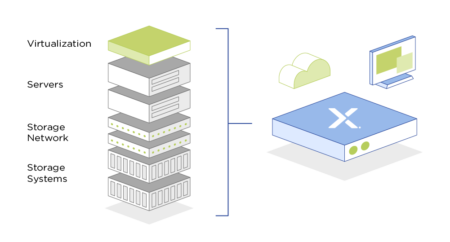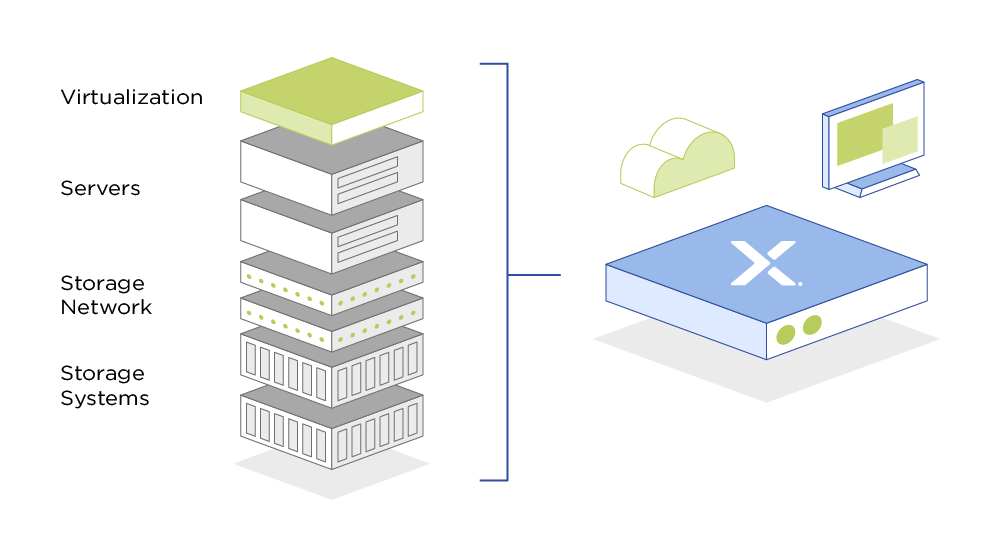 Hyperconverged infrastructures, and hyperconverged storage system , have become quite interesting techniques for storage and resource management in data centers or in the cloud. If you don’t know these concepts, here we will explain what it is, its advantages, disadvantages, and more…
Hyperconverged infrastructures, and hyperconverged storage system , have become quite interesting techniques for storage and resource management in data centers or in the cloud. If you don’t know these concepts, here we will explain what it is, its advantages, disadvantages, and more…
Index of contents
- What is HCI or Hyperconverged Infrastructure?
- What is converged storage?
- What is hyperconverged storage?
- Advantages and disadvantages of hyperconverged storage
What is HCI or Hyperconverged Infrastructure?
This convergence should not be confused with the one presented by some such as Canonical, Microsoft, etc., to converge the desktop and mobile devices. Here we refer to another type of convergence. Specifically, a hyperconverged infrastructure or HCI (HyperConverged Infrastructure) refers to a team that centralizes and brings together all the elements of a traditional data center: storage, computing resources, network and management.
Virtualization software will be able to bundle and unbundle available resources and then dynamically allocate them among virtual machines or containers.
You may also be interested in knowing about GPU virtualization
Thanks to this, an HCI can be useful for applications such as:
- Implement a private cloud, with lower costs, greater control and security improvements.
- Extend the public cloud environment with better ecosystems, faster start-up and infrastructure management.
- Achieve a true hybrid cloud, with applications based on virtual machines and containers.
- Data protection such as disaster recovery or backup systems.
- VDI (Virtual Desktop Infrastructure) systems.
- Implementation of server systems for companies or offices where you need to have the resources on site and not in a data center.
- VPS or Virtual Private Servers, that is, virtual private servers.
On the other hand, it should also be noted that there are some very important companies dedicated to this sector of hyperconverged storage, and quite outstanding products. For example, we have some products like:
- Dell EMC VxRail, a hyperconverged platform that combines Dell PowerEdge servers and VMWare vSAN HCI virtualization software.
- Dell EMC XC Series HCI using Nutanix software and PowerEdge servers from this hardware company.
- HPE, the enterprise division of HP, also has some hyper-converged systems. In fact, the company bought SimpliVity in 2017, a company that pioneered software of this type and that they can now combine with their HPE ProLiant servers.
- Cisco HyperFlex HCI is another of the applications that consists of UCS (Unified Computing System) hardware and HCI software from Springpath Inc, a company that was also bought by Cisco in 2017.
- Lenovo, the great china of HPC and servers, also has a multitude of hyperconverged platforms available among its products, and that can be used with various software, such as Nutanix and also WMWare and others.
Nutanix Virtual Computing Platform and SimpliVity OmniCube were two of the pioneering HCI solutions and the first to be released. Later, other solutions or products from other vendors appeared, such as Maxta Inc. and its Maxta Storage Platform, Nimboxx Atomic Unit of hardware, Pivot3 vSTAC, Scale Computing HC3, and the famous WMWare Virtual SAN or vSAN software from the well-known virtualization company. .
However, here what interests us the most is what is called hyperconverged storage , which is what we are going to in the following sections…
If you want to have your own cloud at home, you should also read our guide with the best NAS
What is converged storage?
First of all I would like to describe what converged storage is . That is, a storage architecture that will combine compute and storage resources into a single identity. This differs from a traditional architecture, where compute and storage resources are separated in the data center.
In this way, workloads that are increasingly dynamic are improved , and that manage to take advantage of this type of architecture better than the traditional one. In this way you can converge or join the storage server, the application, and the data, to offer better services by having a common hardware platform.
Many of today’s Intel Xeon and AMD EPYC-based systems conform to this type of storage architecture. Ideal for applications such as VPS, etc.
| CONVERGED STORAGE | HYPERCONVERGED STORAGE | |
| Architecture | Storage, network, and compute components in a server rack, but can be separated. | Software-defined network where we have all the resources unified and cannot be separated. |
| Storage | The storage comes as a unit and is dedicated to a specifically designated compute node and not to the cluster. | Storage is attached to the node and is shared with the overall cluster-wide storage pool. |
| scalability | Devices can be added to the rack or system on a granular basis. | New modules or nodes need to be added. |
| resource management | Storage is managed separately, but can be partially managed through storage policies at the hypervisor level. Other resources will need other additional applications for their management. | They include hypervisor, software-defined storage, and virtualized networks running on standard hardware. All virtualized resources are managed through a single, centralized web-based user interface. |
What is hyperconverged storage?
Hyperconverged storage takes storage infrastructure a step further. An architecture that combines computing and networking in a single virtualized system. A purely software-defined approach, where we have a much more flexible system to host data and without depending on dedicated hardware.
In this case, each node will include software that virtualizes the resources and will be able to distribute them as needed. As for the networks, they will be defined by software (SDN Software Defined Network) and a load balancing process will be carried out to optimize the use of the hardware that has to take care of it.
In short, hyperconverged storage makes the job of system administrators easier , with a number of very interesting advantages for data center owners.
Advantages and disadvantages of hyperconverged storage
All this hyper-converged storage architecture leads to the development of a series of advantages over converged and non-converged or conventional storage. The most prominent are:
- Greater flexibility and versatilitywhen managing this type of system.
- Cost reduction, since operating expenses are lower due to having a higher degree of administration and ease of system management. On the other hand, administrators can spend some of the time that they don’t have to spend on certain tasks on other common ones that are also necessary, which could mean having fewer dedicated staff.
- Savings in storage, by not needing storage hardware outside of the standard and cheapest solutions.
However, not all benefits. We also have to highlight some disadvantages that can occur:
- Poor scalability,when it comes to heavy-use applications, since the scale-up capabilities in a hyper-converged storage architecture are not as good as in traditional solutions.
- High complexity,by needing a new organizational model for the management of servers or data centers different from traditional systems. Also, centralizing everything requires new planning and organization that adds complexity.
- Vendor lock-in, due to limited compatibility of HCI hardware and software.
I hope that now you have a better understanding of what hyperconverged storage is and its advantages… Do not forget to comment if you have any doubts
